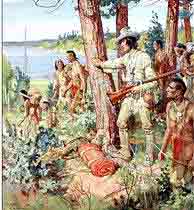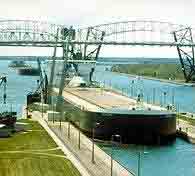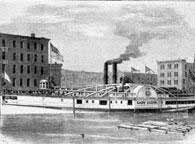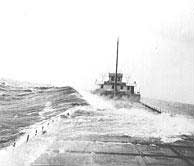VOICE ONE:
I'm Steve Ember.
VOICE TWO:
And I'm Barbara Klein with EXPLORATIONS in VOA Special English.
This week, we tell about the biggest system of freshwater lakes in the world, the Great Lakes between the United States and Canada. They are busy shipping paths. They are also known for fierce and deadly storms. Today, we tell about the lakes and some famous shipwrecks.
(MUSIC)
VOICE ONE:

Even before European explorers first saw the Great Lakes, they provided Native Americans with a way to transport goods. Probably the first European to see and explore the Great Lakes was Frenchman Etienne Brule in the early 1600s. He lived among the Huron Indians. All but one of the Great Lakes has a name from Native American languages: Michigan, Huron, Erie and Ontario. The biggest lake, Superior, was named by the French. But the Ojibwe Indians knew it as Gitchigumi, or "big water."
VOICE TWO:
The Great Lakes are part of a waterway that extends from the Atlantic Ocean to the center of North America. Ships can enter the Saint Lawrence River on the east coast of Canada and travel to Chicago, Illinois or Duluth, Minnesota.
Vessels on the Great Lakes are not called ships, but boats. However, boats on the lakes can be huge. The newest of the lake freighters is over 300 meters long.
The Griffin was the one of the first sailing vessel on the Great Lakes and also among the first shipwrecks. French explorer and trader Rene-Robert Cavelier De La Salle, built it in 1679. The boat set sail from an island in northern Lake Michigan. La Salle reached what is now Green Bay, Wisconsin. He sent the boat back home with a load of animal fur. No one ever saw the Griffin again. The loss of the Griffin established a long tradition of danger and mystery linked to Great Lakes travel.
VOICE ONE:

Trade on the lakes increased. Soon, settlers came to the area. They grew crops and harvested wood, sending products to markets by boat. Then, expanding communities needed coal which was also shipped.
In the 1840s, iron ore was discovered in the Marquette Mountains in the Upper Peninsula of Michigan. Iron ore, the main raw material of steel, changed the lakes area and the nation.
In 1855, the first canal connecting Lake Superior with Lake Huron was completed at Sault Ste. Marie, Michigan. The Soo Locks linked iron mines near Lake Superior with the cities of Detroit, Michigan; Cleveland, Ohio and Chicago, Illinois. Today, the Soo Locks are the world's busiest.
VOICE TWO:
Passenger travel also grew on the Great Lakes. Big steamboats carried hundreds of people between cities. But the threat of fire came with the new steam technology. The worst fire disaster happened on Lake Erie in 1850.
The G.P. Griffith was traveling from Buffalo, New York to Chicago with about 300 men, women and children. Many were immigrants from England, Ireland and Germany.
Not far east of Cleveland, a fire broke out. As the flames spread, passengers and crew panicked. More than 100 people jumped into the lake and drowned. Others burned. Only a few strong swimmers survived. But not a single child and only one woman was saved.
(MUSIC)
VOICE ONE:

With thousands of boats on the lakes, collisions became a real danger. The deadliest took place in 1860 in southern Lake Michigan. The steamer Lady Elgin was carrying passengers from Milwaukee, Wisconsin to Chicago to hear a speech by Democratic presidential candidate Stephen Douglas. As many as five to six hundred people were on board, many of Irish ancestry.
A storm blew up on the return trip to Milwaukee. The Augusta, a boat carrying wood, was sailing south at high speed. It struck the Lady Elgin. But the Augusta's Captain D.M. Malott continued on to Chicago, failing to help victims on the passenger boat.
Captain Jack Wilson struggled to save the Lady Elgin. But the boat soon sank. Hundreds of passengers struggled to hold on to the floating wreckage. Powerful waves crashing against a rocky coast drowned many people. The captain fought to save as many people as he could until he too was lost.
Northwestern University student Edward Spencer was another hero. He swam from shore and rescued 17 people. The wreck of the Lady Elgin remains the worst loss of life on open water in the Great Lakes. Recent studies say 400 or more people died that night.
VOICE TWO:

As the nation's need for steel grew, bigger ships were built to carry iron ore. They sailed on the lakes until late November. Shipping in the upper Great Lakes mostly stops in late fall because of ice. But November storms can be deadly.
The worst weather disaster on the lakes happened in 1913. The early November winds reached hurricane force and caused waves 11 meters high. By the time the storm eased, eight big boats were lost on Lake Huron alone. They included the Canadian freighter James Carruthers which disappeared with 22 men. Its wreck has never been found. The storm, sometimes called the "Big Blow," killed more than 250 people.
VOICE ONE:
Some of the biggest boats to ever sail the lakes have been lost in sudden November storms. In 1958, the Carl D. Bradley was heading home at the end of the shipping season. It first launched 30 years before. At the time, it was the biggest boat on the Lakes. But during a storm on Lake Michigan, the Bradley split in two. Only two of its crew of 35 survived.
The Edmund Fitzgerald was launched the same year the Bradley sank. The Fitzgerald was 220 meters long. It was the biggest boat on the lakes when it entered service. It would become the most famous shipwreck of all.
Canadian folksinger Gordon Lightfoot told the story of the tragedy in "The Wreck of the Edmund Fitzgerald."
(MUSIC)
VOICE TWO:

On November 10th, 1975, the Fitzgerald was sailing on Lake Superior. It was struggling through a dangerous storm that the old sailors called a "November witch." It had lost its radar and the old lighthouse at Whitefish Point, Michigan was not operating.
Captain Ernest McSorley radioed another freighter, the Arthur Anderson, that his boat was taking on water. He was making for the safety of Whitefish Bay. But that night the weather got worse. The Anderson reported winds of about 140 kilometers an hour and waves ten meters high.
Captain McSorley told the Anderson: "We are holding our own." But that was the last anyone heard from the Edmund Fitzgerald. The boat and 29 men disappeared into Lake Superior minutes later.
(MUSIC)
VOICE ONE:
Tom Farnquist is executive director of the Great Lakes Historical Shipwreck Society. In 1995, he was part of an effort to recover the Fitzgerald's bell. The bronze bell is now preserved at the Great Lakes Shipwreck Museum at Whitefish Point, Michigan. Each year on November 10th, a ceremony is held there to remember the crew members of the Fitzgerald.
Tom Farnquist knows as much about shipwrecks on the Great Lakes as anyone.
TOM FARNQUIST: "The lakes are very treacherous. There's over 6,000 and some estimate as high as anywhere to ten to twelve thousand shipwrecks on the Great Lakes."
VOICE TWO:
Today, thousands of people dive at shipwreck preserves all around the Great Lakes. The Great Lakes Historical Shipwreck Society works to preserve and explain the history and importance of the area's wrecks. The group was established in 1978. It has grown to over 1,700 members.
Each year, tens of thousands of people visit the shipwreck museum at Whitefish Point. Great Lakes shipwrecks continue to capture the imagination of Americans from all over the country.
Tom Farnquist says shipwrecks are exciting because they preserve a detailed picture of maritime life that can be hundreds of years old. He says Lake Superior may be one of the most interesting places for this kind of exploration.
TOM FARNQUIST: "It's quite a cross-section of American maritime history frozen in time on the Great Lakes. There's probably the best selection of shipwrecks anywhere in the world waiting to be found in Lake Superior."
(MUSIC)
VOICE ONE:
This program was written and produced by Mario Ritter. I'm Steve Ember.
VOICE TWO:
And I'm Barbara Klein. Transcripts, MP3s and podcasts of our programs are at voaspecialenglish.com. You can also find a link to the Great Lakes Shipwreck Museum. Join us again next week for Explorations in VOA Special English.
cross-section: a sample meant to be representative of a whole population 具有代表性的实例,典型
Related stories:
Getting a feel for textile arts around the world
Exploring the art of jewelry across the ages
As the world turns: exploring the art of wood
Hip-Hop goes global to a socially active beat
(Source: VOA 英语点津编辑)